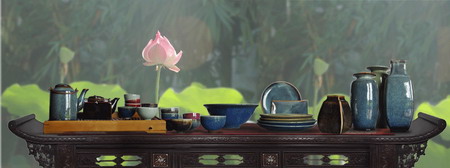Tien Giang: Ceramic Master

Tien Giang of Mekong Delta Province didn't think much about pottery, or if at all, until Francois Jarlov and his Vietnamese wife came and forever changed the economy, maybe even history, and lives of the people as a whole. Mekong Delta's soil is made of alkaline. That is why the local people never thought that making ceramics was even a remote possibility of becoming in fact the major livelihood in the place. But Jarlov has never been more sure in his life and since introducing his work in 2010, his pottery business today has been exporting a large number of his Dong Gia or Eastern home brand tea sets, plates, bowls, and vases. His work is a combination of the soil from his wife's hometown and his acquired knowledge from his own native place of South France where he grew up.Jarlov first set foot in Vietnam in 2000 when he was invited to deliver a lecture at the Hanoi University of Fine Arts on the techniques of making Raku ware, a kind of traditional pottery used in Japanese tea ceremonies. The program was organized by L'Espace, a French culture and language center in Hanoi. It never occurred to him that such program would forever change his life.
Four years after, he gave another talk, at the Ho Chi Minh City's Institute for Culture Exchange with France (IDECAF) and History Museum, but this time about his own pottery creations. In the same year, he published a book about Vietnamese culture and history through his own perspective when he was a young traveler discovering the many faces of the country such as Hanoi, Hue, Da Nang and Ho Chi Minh City. Morever, inspired by a folklore saying the Vietnamese people were bred from a dragon father and a fairy mother, he also released a collection of short stories called “Duoi bong Rong xanh” (Vietnamese)/ “Sous le signe du Dragon Bleu” (French) which means “Under the sign of the blue dragon,” which included his own pictures and paintings and published in both (Vietnamese and French) languages.Jarlov's wife, Phan Thi Thuy Mai, met him during an exhibition in Ho Chi Minh City. She was working in the art business during that time. They became friends and soon worked together, travelling around Vietnam and even across countries like Cambodia. They fell in love and got married, and moved to France to settle. There, they established a pottery barn and held exhibitions and training courses in several cities across Europe and Asia. But several years later, the sentimental and pioneer in Jarlov wanted him to share the story of the Vietnamese people to the world through ceramics. And while Mai didn't have any knowledge about pottery before meeting Jarlov, his husband's passion for the art easily grew on to her as well.So they went around all the pottery villages in Vietnam to choose soil, enamel and building kilns for their products. But at first, the couple encountered problems with their vision.
They had to use Vietnamese materials for glaze, but the trade was a family secret passed on for generatons and therefore no written record of the composition of ingredients. The couple then had to stay and learn the craft themselves, taking them two years to master the art. They also took time to visit fine arts museums, pagodas and temples in order to actually see and touch ancient and authentic Vietnamese pottery. Pottery equipment had to be both imported from France and travelled from the Bat Trang pottry village in Hanoi. The greatest obstacle though was the soil itself which was not suitable for pottery in the first place. Jarlov and his artisans had to work on many and different combinations of soil and French and Vietnamese enamels until they could find the perfect mixture which could sustain the required high temperature of 1,300 degree Celsius. This was even more complicated by the fact that Jarlov only used stone, clay and oxide powder in order to preserve the traditional process of making ceramics.The process was long and tedious, but instead of being discouraged, Jarlov fell in love with Vietnamese pottery even more. And though Tien Giang was far from being a ceramic industry, Jarlov persisted and later on surprisingly succeeded with his dream. Jarlov believed that it was not enough to just look at an item. A person should be able to associate himself with each art piece he sees. And it was in this love for the art that many people were interested in and appreciated his work, curious and eager to learn the story behind each labor of love.Artisans called Jarlov's dream miraculous. But it was a combination of all 30 years of work, knowledge, dedication and pure love for the arts that made Jarlov's dream a reality, an inspiration to everyone all over the world.









